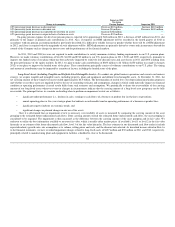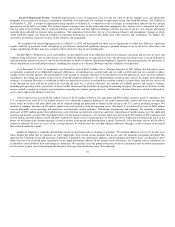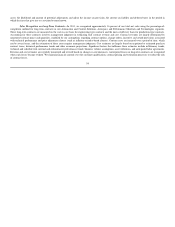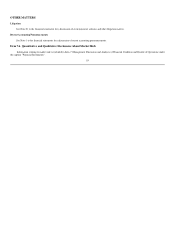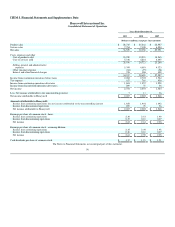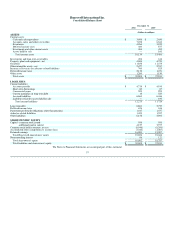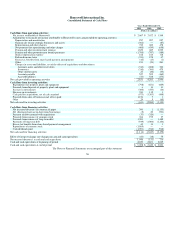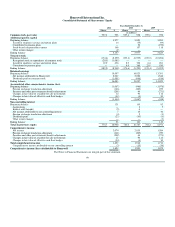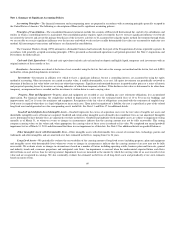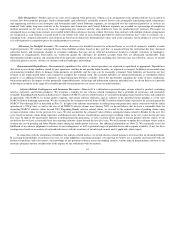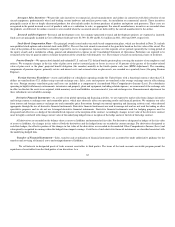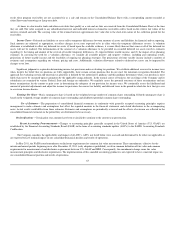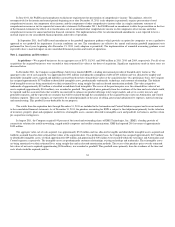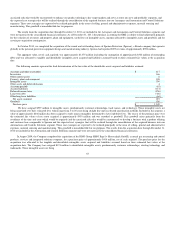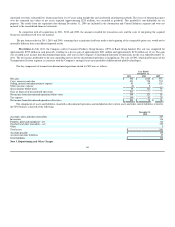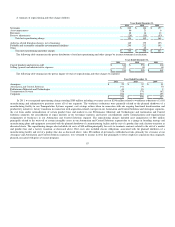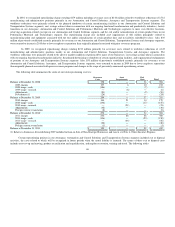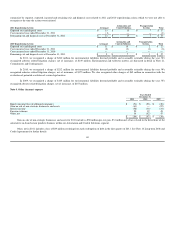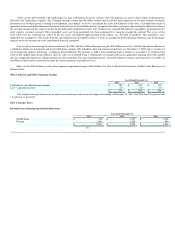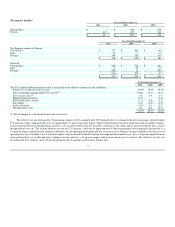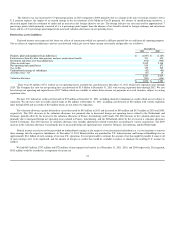Honeywell 2011 Annual Report Download - page 65
Download and view the complete annual report
Please find page 65 of the 2011 Honeywell annual report below. You can navigate through the pages in the report by either clicking on the pages listed below, or by using the keyword search tool below to find specific information within the annual report.
Aerospace Sales Incentives—We provide sales incentives to commercial aircraft manufacturers and airlines in connection with their selection of our
aircraft equipment, predominately wheel and braking system hardware and auxiliary power units, for installation on commercial aircraft. These incentives
principally consist of free or deeply discounted products, but also include credits for future purchases of product and upfront cash payments. These costs are
recognized in the period incurred as cost of products sold or as a reduction to sales, as appropriate. For aircraft manufacturers, incentives are recorded when
the products are delivered; for airlines, incentives are recorded when the associated aircraft are delivered by the aircraft manufacturer to the airline.
Research and Development—Research and development costs for company-sponsored research and development projects are expensed as incurred.
Such costs are principally included in Cost of Products Sold and were $1,799, $1,450 and $1,321 million in 2011, 2010 and 2009, respectively.
Stock-Based Compensation Plans—The principal awards issued under our stock-based compensation plans, which are described in Note 20, include
non-qualified stock options and restricted stock units (RSUs). The cost for such awards is measured at the grant date based on the fair value of the award. The
value of the portion of the award that is ultimately expected to vest is recognized as expense over the requisite service periods (generally the vesting period of
the equity award) and is included in selling, general and administrative expense in our Consolidated Statement of Operations. Forfeitures are required to be
estimated at the time of grant in order to estimate the portion of the award that will ultimately vest. The estimate is based on our historical rates of forfeiture.
Pension Benefits—We sponsor both funded and unfunded U.S. and non-U.S. defined benefit pension plans covering the majority of our employees and
retirees. We recognize changes in the fair value of plan assets and net actuarial gains or losses in excess of 10 percent of the greater of the market-related
value of plan assets or the plans' projected benefit obligation (the corridor) annually in the fourth quarter each year (MTM Adjustment). The remaining
components of pension expense, primarily service and interest costs and assumed return on plan assets, are recorded on a quarterly basis (On-going Pension
Expense).
Foreign Currency Translation—Assets and liabilities of subsidiaries operating outside the United States with a functional currency other than U.S.
dollars are translated into U.S. dollars using year-end exchange rates. Sales, costs and expenses are translated at the average exchange rates in effect during
the year. Foreign currency translation gains and losses are included as a component of Accumulated Other Comprehensive Income (Loss). For subsidiaries
operating in highly inflationary environments, inventories and property, plant and equipment, including related expenses, are remeasured at the exchange rate
in effect on the date the assets were acquired, while monetary assets and liabilities are remeasured at year-end exchange rates. Remeasurement adjustments for
these subsidiaries are included in earnings.
Derivative Financial Instruments—As a result of our global operating and financing activities, we are exposed to market risks from changes in interest
and foreign currency exchange rates and commodity prices, which may adversely affect our operating results and financial position. We minimize our risks
from interest and foreign currency exchange rate and commodity price fluctuations through our normal operating and financing activities and, when deemed
appropriate through the use of derivative financial instruments. Derivative financial instruments are used to manage risk and are not used for trading or other
speculative purposes and we do not use leveraged derivative financial instruments. Derivative financial instruments used for hedging purposes must be
designated and effective as a hedge of the identified risk exposure at the inception of the contract. Accordingly, changes in fair value of the derivative contract
must be highly correlated with changes in fair value of the underlying hedged item at inception of the hedge and over the life of the hedge contract.
All derivatives are recorded on the balance sheet as assets or liabilities and measured at fair value. For derivatives designated as hedges of the fair value
of assets or liabilities, the changes in fair values of both the derivatives and the hedged items are recorded in current earnings. For derivatives designated as
cash flow hedges, the effective portion of the changes in fair value of the derivatives are recorded in Accumulated Other Comprehensive Income (Loss) and
subsequently recognized in earnings when the hedged items impact earnings. Cash flows of such derivative financial instruments are classified consistent with
the underlying hedged item.
Transfers of Financial Instruments—Sales, transfers and securitization of financial instruments are accounted for under authoritative guidance for the
transfers and servicing of financial assets and extinguishments of liabilities.
We sell interests in designated pools of trade accounts receivables to third parties. The terms of the trade accounts receivable program permit the
repurchase of receivables from the third parties at our discretion. As a
62


